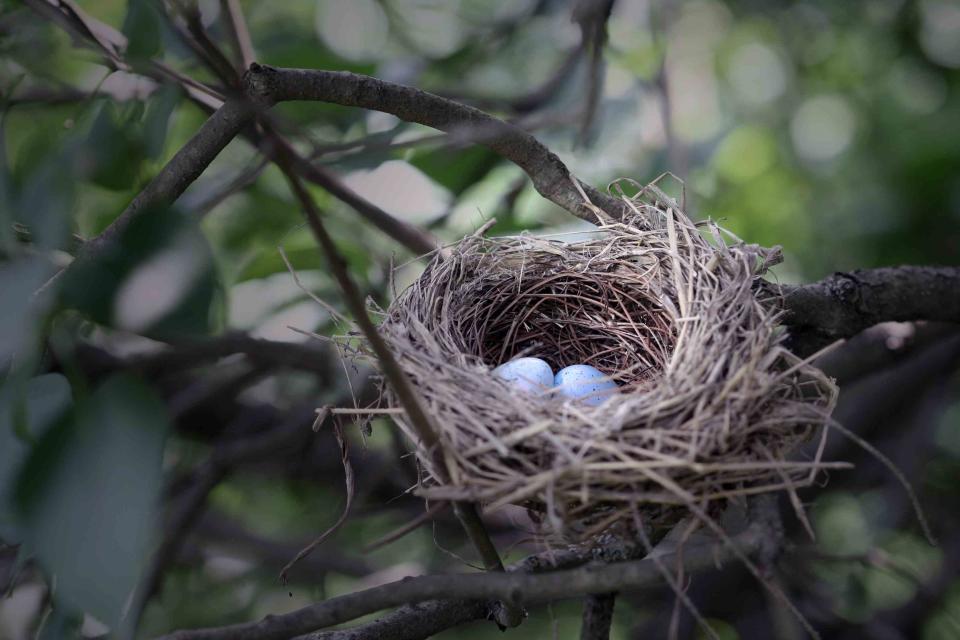Why You Shouldn't Trim or Cut Down Trees in Spring
Waiting until fall or winter helps protect wildlife and the trees themselves.

Fact checked by Haley Mast
It’s that time of year. Along with the singing birds and croaking frogs, there’s the sound of chainsaws and stump grinders as some people remove trees from their properties.
Although spring is a good time to do general garden cleanup, it may not be the best time to trim and cut down trees.
“People are often eager to get outside in the spring when the weather warms. This is when they often may see or feel inclined to do yard work and gardening," says Catriona Glazebrook, executive director of WellKind. The group focuses on the protection and restoration of the natural world with an emphasis on forests, biodiversity, and wildlife.
“While gardening is perfect for this time of year, cutting/trimming/using heavy and loud equipment outside, etc. is not.”
Although warm weather and an urge to spring clean makes it seem like a good time to tackle the trees, there are plenty of reasons why you might want to wait.
One of the main reasons is to protect wildlife.
“The vast majority of wildlife (birds/mammals) rear their young in the spring when things are sprouting, blooming, insects are hatching, and there is a better food supply for offspring,” Glazebrook says. “The warmer days are also better for keeping eggs and newborns alive when busy parents have to seek out food and may need to leave offspring/young alone in the nest or den.”
According to PAWS Wildlife Center in the Puget Sound region of Washington state, which is home to many species that make their homes in trees.
“Trees and forests provide critical food sources, cover, and nesting sites for many of these wild species,” the center points out on its website. “Woodpeckers, cavity-nesting owls, squirrels, and bats take advantage of standing dead trees, and a multitude of birds grace the branches of still-living trees with their amazing and varied nests.”
The group receives hundreds of baby wild animals each year, many of which lost their homes when a tree was cut down.
“Please be aware that pruning or cutting down trees and hedges during the breeding season can and does displace, harm, or even kill wild animals.”
Even the sounds of tree work can be harmful to wildlife. The loud noise can keep animal parents from returning to their nests. The commotion can also keep them from feeding their offspring in a timely enough manner to keep them healthy and alive.
“I managed one of the largest sanctuaries in the United States and my coastal conservation program contributed greatly to the comeback of an endangered species,” Glazebrook says. “One of the main reasons for this was our team's efforts to get the Army Corp of Engineers to stop their dredging operations in the spring. Once they moved this work to the fall—we saw an immediate uptick in hatchlings.”
Best Time to Trim
Trimming and cutting trees in spring isn’t just harmful to wildlife; it can also be dangerous for the trees themselves.
Trees are dormant in late fall and winter. That means that bacteria, fungi, parasites, and insects that can live on them and spread disease are also either dormant or dead. Those diseases are less likely to As a result, diseases are less likely to be transmitted when you prune in winter.
Normally, during pruning, a tree is stimulated to produce new growth. Trimming when a tree is dormant, doesn’t trigger that growth.
The Colorado State Forest Service recommends pruning in late winter, from late February to early March, in that area.
“Pruning trees during the late dormant season reduces impacts on tree health, and builds a strong structure for our community trees in the long term,” Keith Wood, urban and community forestry manager for the Colorado State Forest Service, said on the organization’s website.
PAWS suggests November through January. Glazebrook says the best time to trim most trees is from late October to early January.
“Thinning or pruning trees in the growing season when pests and diseases are more active in warmer weather exposes trees that have been newly wounded, and have not had time to cover over with new growth, to potential infestation and infection from disease,” she says.
To confirm what’s best where you live, ask a local arborist or extension agent.
Threats to Birds and Trees
Keeping trees healthy and alive has greater climate ramifications, of course.
According to the “State of the World’s Trees” report from Botanic Gardens Conservation International in September, 2021, 30% of tree species are threatened with extinction, and at least 142 tree species are extinct in the wild.
“The main threats to tree species are forest clearance and other forms of habitat loss, direct exploitation for timber and other products and the spread of invasive pests and diseases,” the authors write. “Climate change is also having a clearly measurable impact.”
Birds, who rely on trees for shelter and food, have had huge population declines. The number of birds in the U.S. and Canada has dropped by 29% over the past 50 years, according to a study published in the journal Science. That's an overall decline of 2.9 billion birds since 1970.
“Not doing major yardwork (besides gardening) in the spring is probably one of the number one ways that homeowners and land managers can do their part to help biodiversity and protect the health of their trees,” Glazebrook says.
She suggests the best thing to do outdoors in the spring is working on a garden.
“To everything there is a season,” she says. “Sometimes all we need to do is get back in touch with the natural seasons of our planet and the needs of living things to help do our part in protecting nature and ensuring that we are helping many species survive, thrive and be able to start that next generation.”

